Chirps of birds had threaded through the branches early one June morning as we strolled along the path at Palms Book Park near Manistique. The buzzing insects had answered the bird calls as Chuck and I stepped quietly, clad in our bug shirts. Suddenly the glassy water of Michigan’s largest spring came into view. Struck with awe, I stopped and gazed at how the surface had mirrored the proud pines standing guard over this wonder of nature, Kitch-Iti-Kipi, Michigan’s largest spring.
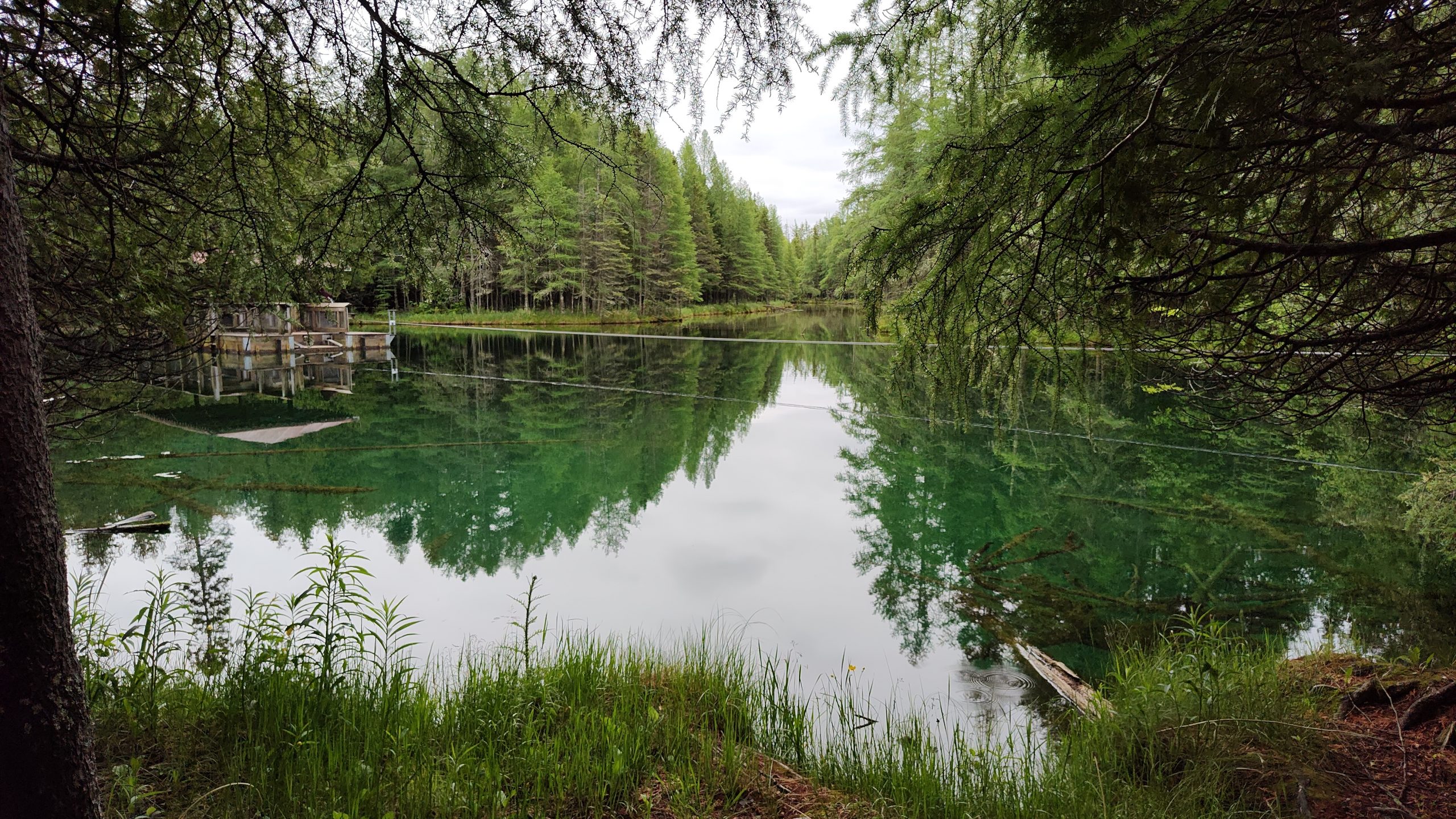
with 10,000 gallons of cool water every single minute.
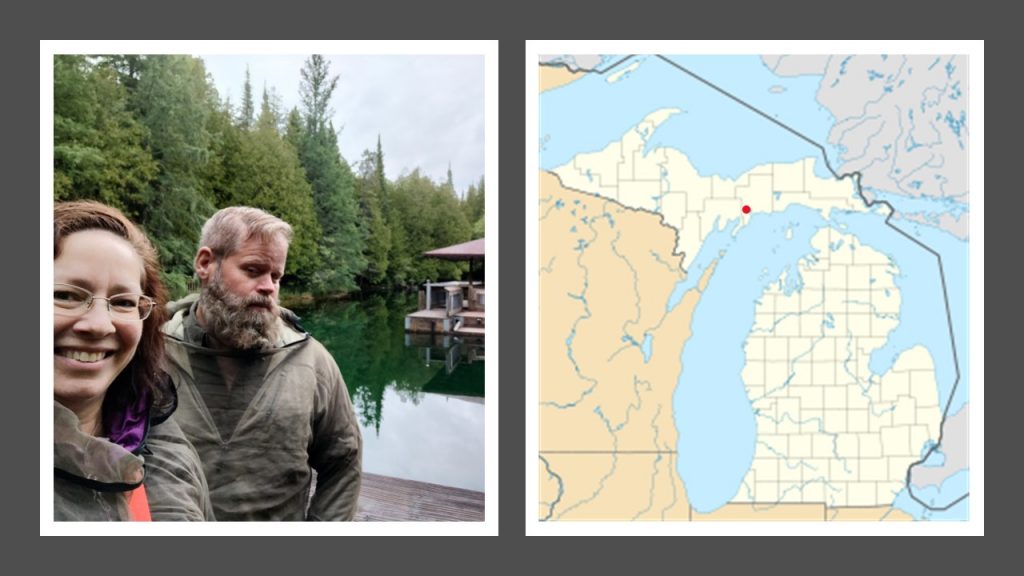
By the time we’d reached the dock, a pair of fellow tourists had silently started cranking the self-guided raft back toward shore. The vessel whispered over the water.
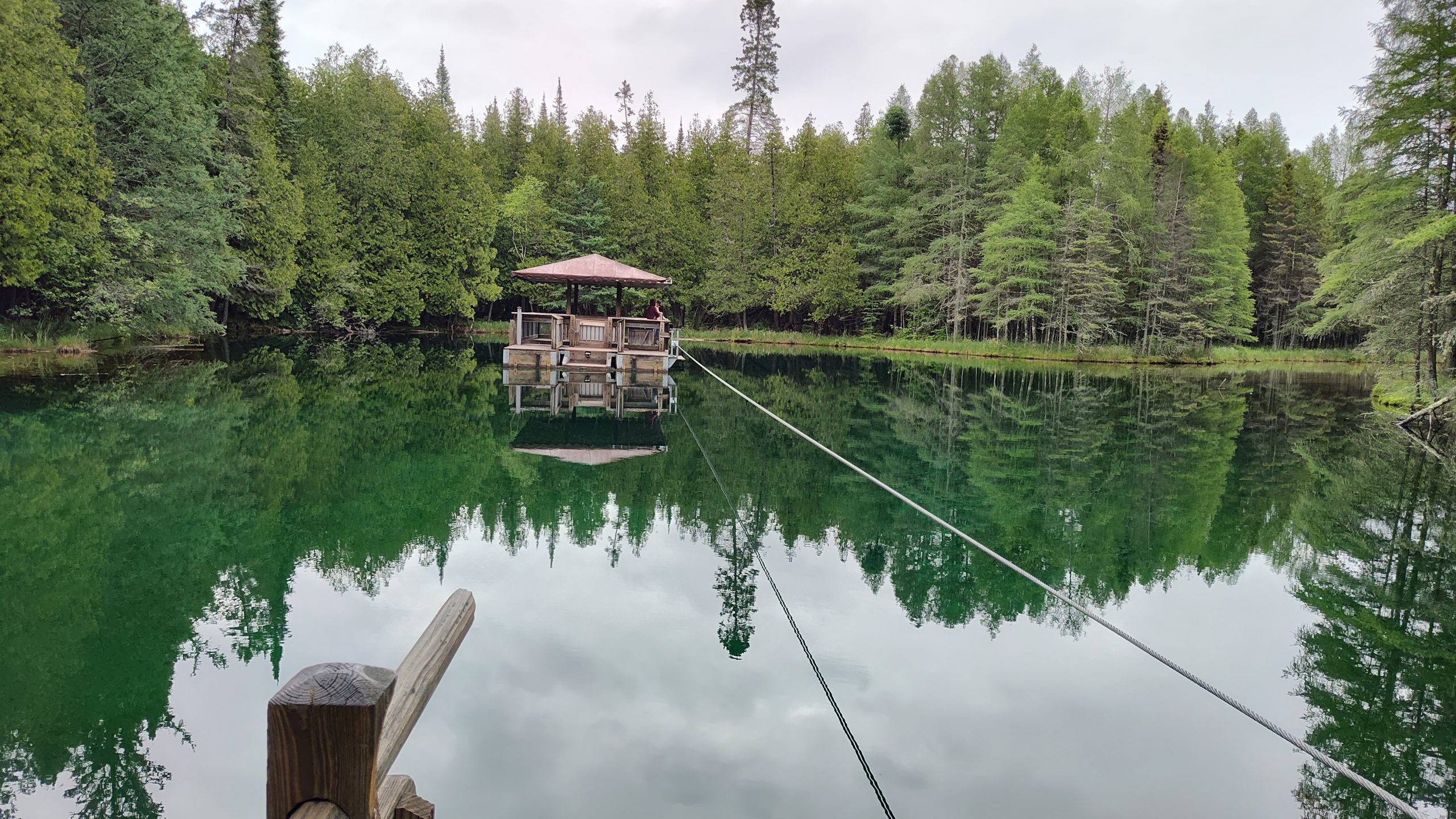
In the winter, this place must be magical! (Plus, there wouldn’t be any mosquitoes!)
Our Turn on the Raft
As the raft neared the shore, we had felt wrapped in the calmness of the quiet pond. The couple had greeted us with hushed tones as we stepped over the threshold. I wondered if we’d see wildlife.
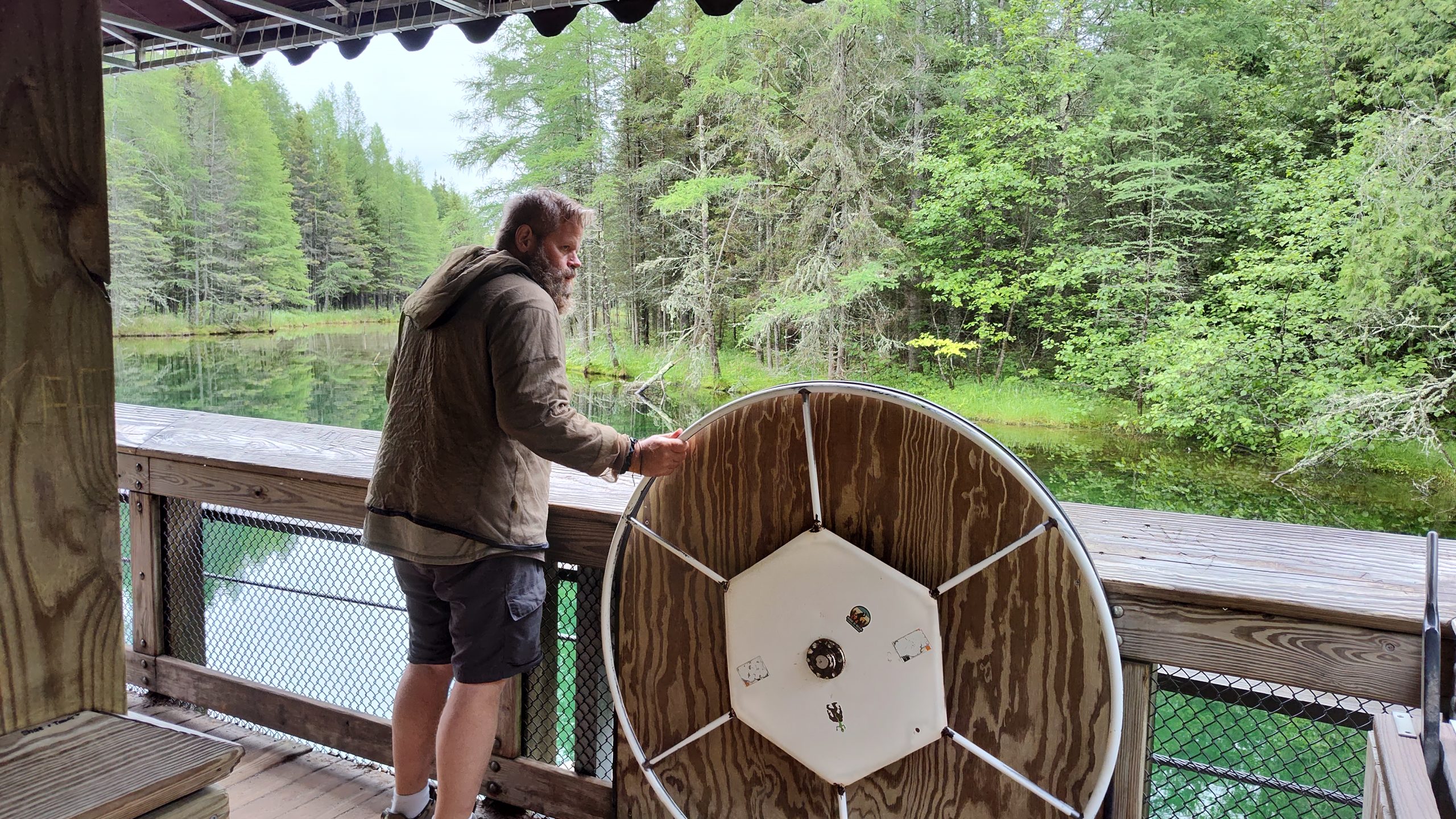
The center of the large raft had been removed and a safety railing had been built around the perimeter. What an ingenious method for visitors to see this spring far below!
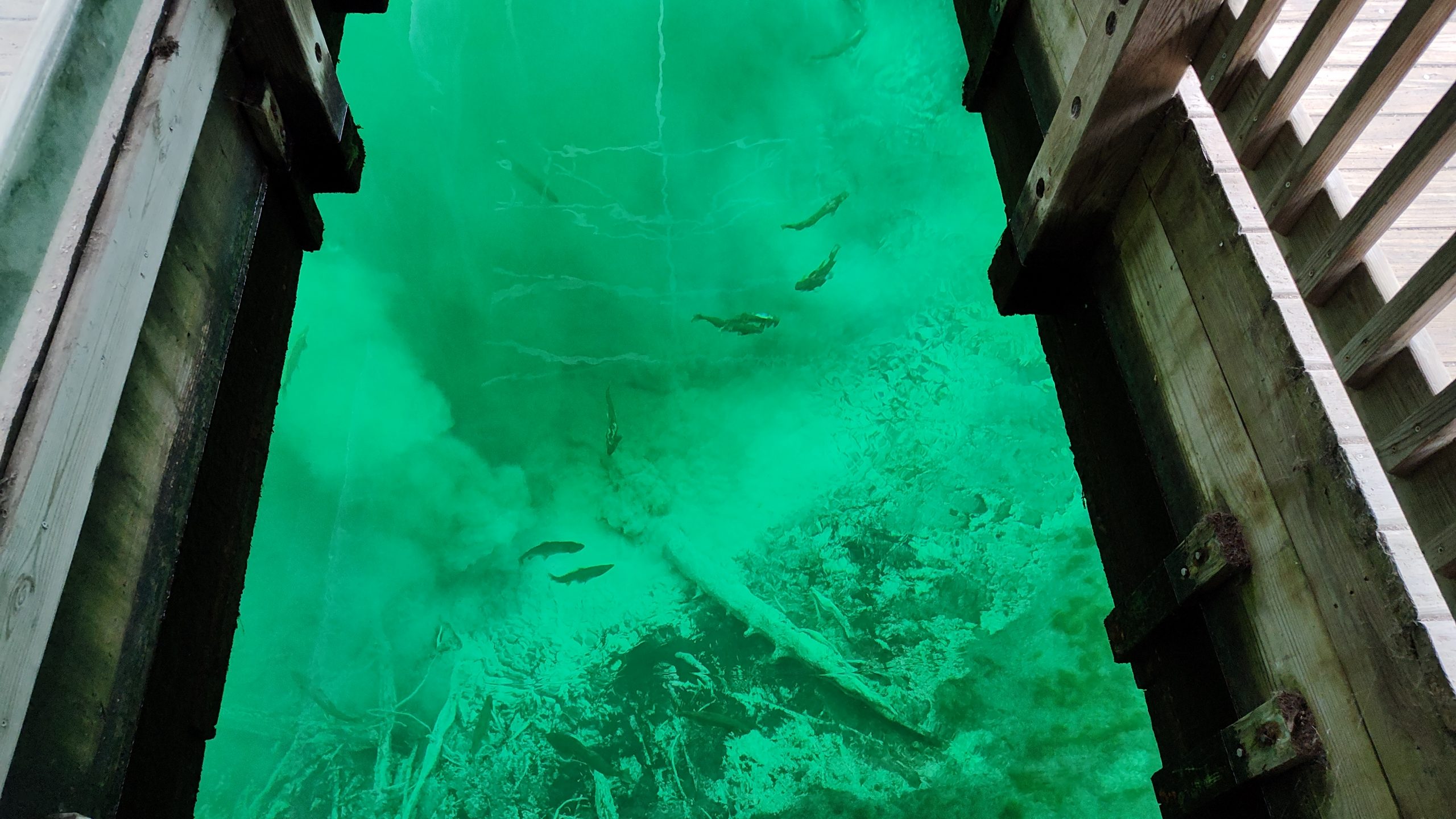
Soon we could peer into the magical world of Lake Trout, Brown Trout and, our State fish, the Brook Trout’s habitat. “You can see the spring water coming up through the cracks in the bottom.” Chuck had commented. According to the park worker, the green tint is due to the water traveling through the limestone and picking up minerals.
What’s the story of this spring? Who had created this park?
“Kitch-Iti-Kipi” Meaning
Chippewa tribes had inhabited this area calling the body of water, “Kitch-Iti-Kipi,” which means “Big Spring.” This pond had been known by many names: “The Great Water,” “The Blue Sky I See,” “Mirror to Heaven” and “Bubbling Spring.” Even though it’s silent some have even called it: “The Roaring,” “Drum Water” and “Sound of Thunder.”
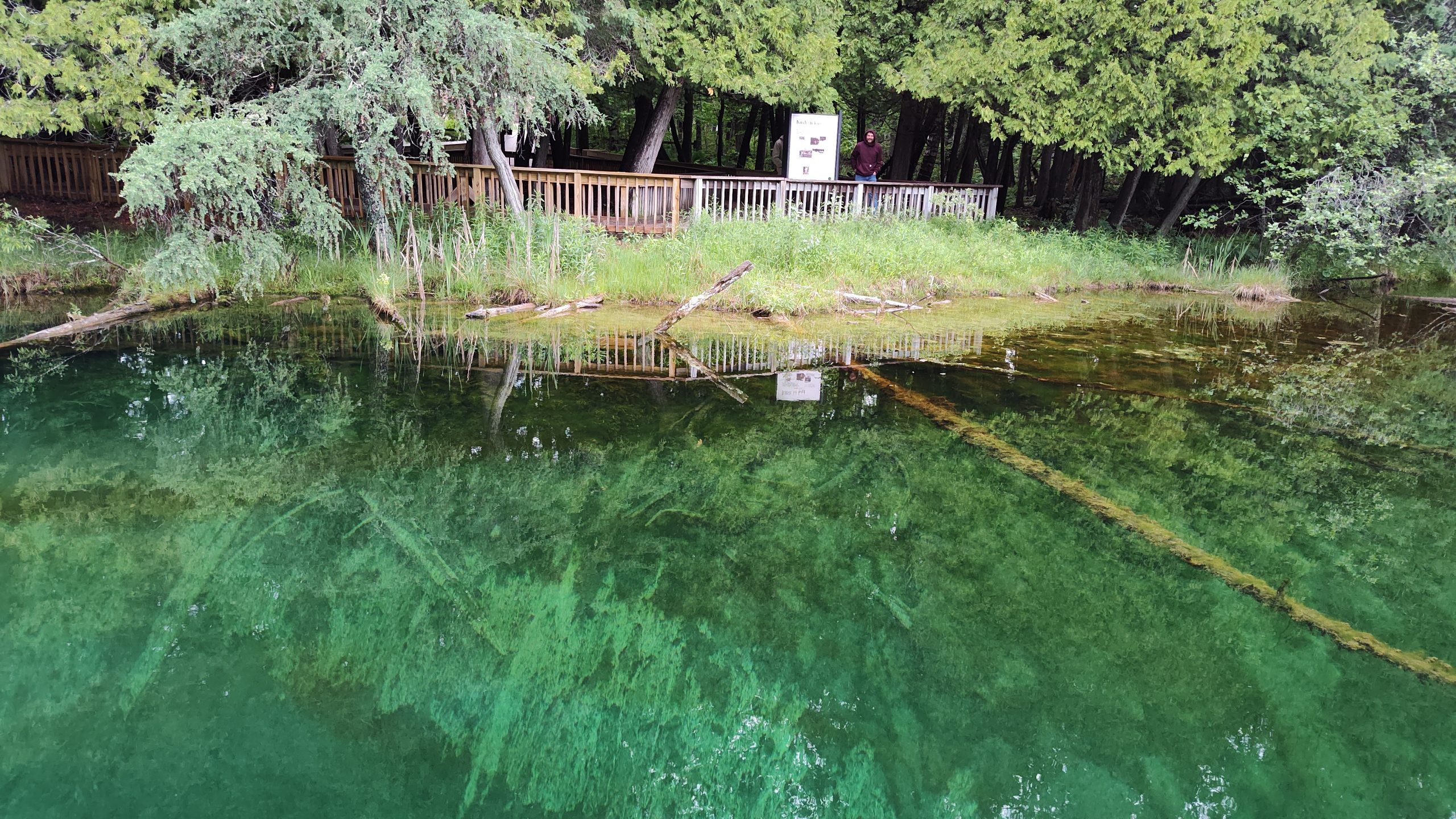
The Kitch-Iti-Kipi Legend
The Anishinaabe tribes have carried their legends from one generation to the next through story telling, rarely writing them down. A variety of versions of the Kitch-Iti-Kipi Legend have been shared through the centuries. However, author, Carole Lynn Hare, had found her Great Great Aunt Pearl’s published booklet in 1969 when cleaning out her Aunt’s home.
This booklet had contained the Kitch-Iti-Kipi tale told to Carole’s Great Great Great Grandmother by the well known, Squaw Mary. “The story Squaw Mary told my great great great grandmother is what has been told for more than a hundred years.” Carole, whose Native name is Miskwa Anang Kwe (Red Star Woman), had been inspired to pen this native tale. See the link under “Resources” if you’d like to purchase the book. Here’s my synopsis of the story:
Little Fawn and Young Eagle had grown up together as friends. As the seasons passed the pair had planned to marry. Big Buck, the young, selfish chief, had desired Little Fawn’s affection and had been jealous of Young Eagle. When Little Fawn refused Big Buck’s advances, Big Buck had taken Young Eagle out to the woods for a hunting trip and had caused Young Eagle to drown in the Kitch-Iti-Kipi spring.
As the air grew colder, the tribe still hadn’t found Young Eagle. The band had to move to their winter location down south without the youthful brave. Little Fawn had remained inconsolable for months.
As soon as the tribe had returned to Indian Lake, nearby Kitch-Iti-Kipi, for the summer, Little Fawn had gone searching for Young Eagle. She had taken a canoe out into the spring. Big Buck had secretly followed her, still hoping for her affection. As Little Fawn gazed into the turquois water, the swirling sand had stopped and she saw Young Eagle lying at the bottom. Wanting to be with her best friend, she dove into the frigid, crystal spring.
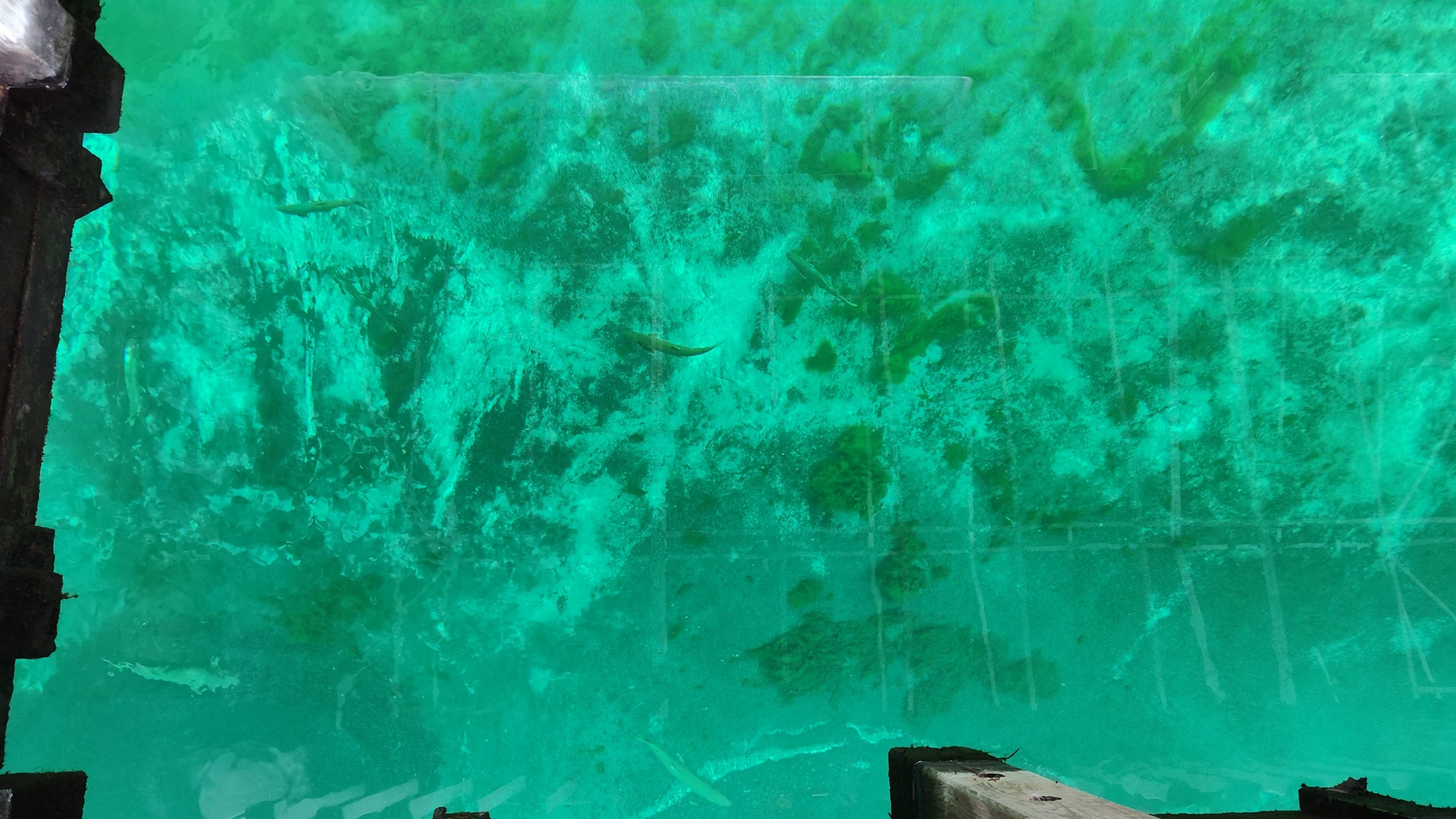
Big Buck had watched in horror as Little Fawn’s body slid quickly to the bottom, resting alongside her love, Young Eagle. In a daze Big Buck heard a rustling across the pond. A small, white deer had suddenly appeared, shaking water from its coat. The animal’s dewy eyes stared directly at Big Buck, then scampered off through the trees. Big Buck knew that a white deer had been a sign of impending doom sent from The Great Spirit.
Before evening fell, Big Buck had paddled away from his village on Indian Lake, never to be seen again. His bitterness, however, still hovers over Indian Lake. Several young men have lost their lives when a black mist swiftly appears over the water not far off shore capsizing their boat and drowning them. This mist is said to be the angry spirit of Big Buck. The tribe had decided to never return to these summer grounds, but rather found another location southwest of Kitch-Iti-Kipi and Indian Lake.
So how did this sacred land fall into the hands of the State?
Book and Palms Land Company
In the early 1900’s Book and Palms Land Company had owned this nearly 90 acre parcel. At that time a lumber camp had been using the area as a dump.
John Ira Bellaire – Conservationist/ Entrepreneur/ Legend Creator
John Ira Bellaire has been credited as the visionary in preserving Kitch-Iti-Kipi. A large rock, adorned with a plaque, sits along the trail honoring him as a conservationist.
In 1928 Bellaire had proposed that the Book and Palms Estate, represented by Frank Book, sell this land to the State of Michigan with the stipulation that the property would “forever be used as a public park, bearing the name Palms Book State Park.” Some accounts say it had been purchased by the State for one dollar while others claim it had been ten dollars.
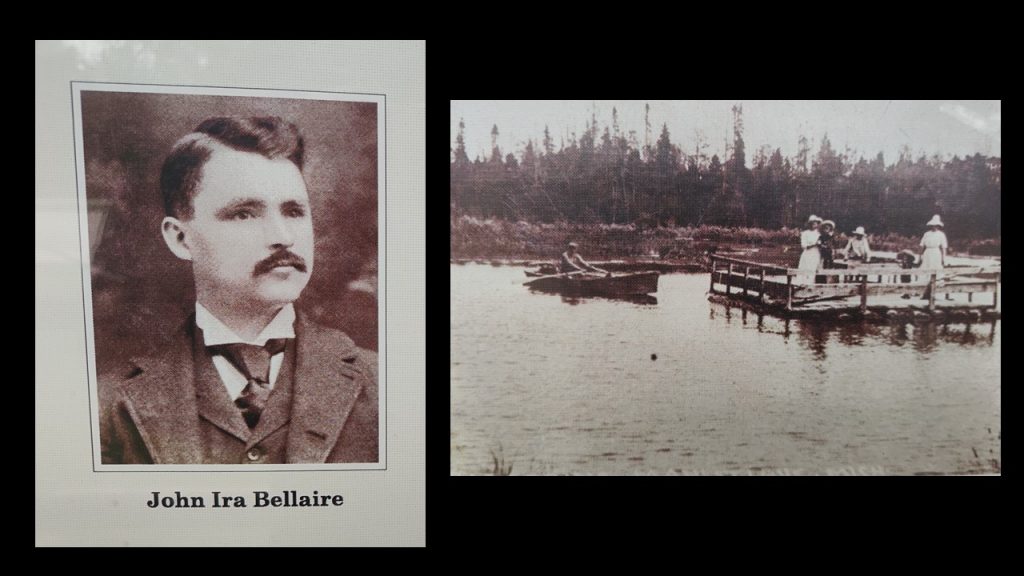
He’d had rafts built to take people to the center of the spring.
John I. Bellaire had said, “The first time I saw the spring it was not more than a black hole mostly covered by fallen trees. A lumber camp (Camp 22) in the vicinity threw their rubbish into it. I could have purchased the land myself but instead I made the contacts to have the State acquire it.”
So what had been John I. Bellaire’s motivation for securing this land as a park? I dug a little deeper.
It just so happened that John I. Bellaire, an entrepreneur, had recently left the dwindling lumber business in 1920 and reestablished himself as a store owner. He’d evidently saw the Kitch-Iti-Kipi spring as an opportunity to make a profit, but hadn’t wanted the responsibility of being the caretaker. Bellaire had been known to sell the water and sand from the spring claiming medicinal powers of these elements. He would often close his store to take people on private tours of Kitch-Iti-Kipi for a pre-selected price. At that time only a train had traveled nearby the spring-fed pond.
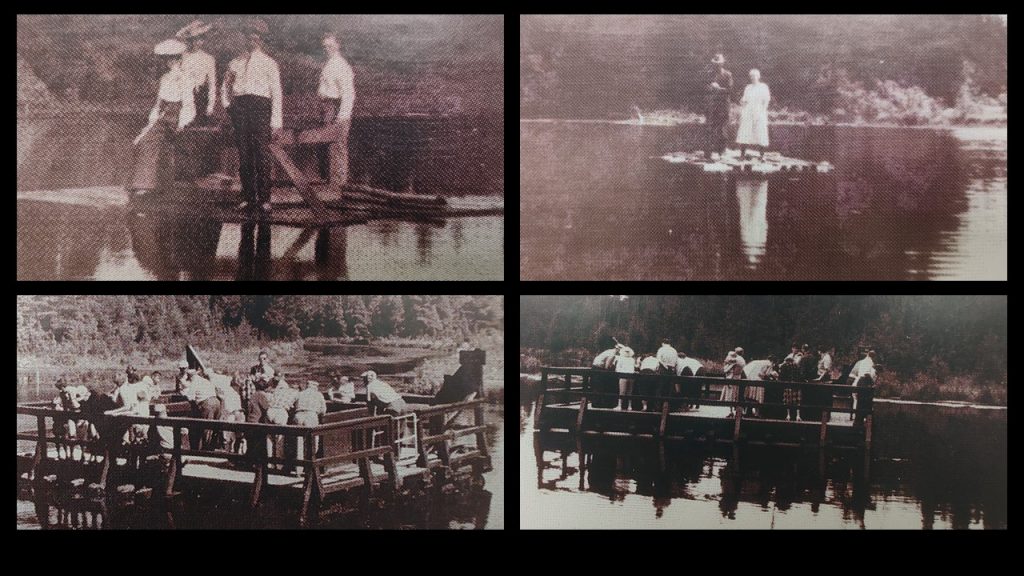
Photo credits: Kitch-Iti-Kipi visitor center
More legends emerged about Kitch-Iti-Kipi. These had actually been heralded from John I. Bellaire, himself, which he’d admitted near the end of his life. This had been a way to increase visitors to the area. One such tale had been claimed that by grinding up tamarack bark, which grows around the perimeter of the pond, and placing it in one’s empty pockets, that it would be replaced by gold exactly at midnight. Yet another had been placing a drop of honey on a strip of birch bark and dipping it into the spring would make the loved one receiving this gift “true forever.”
Civilian Conservation Corp
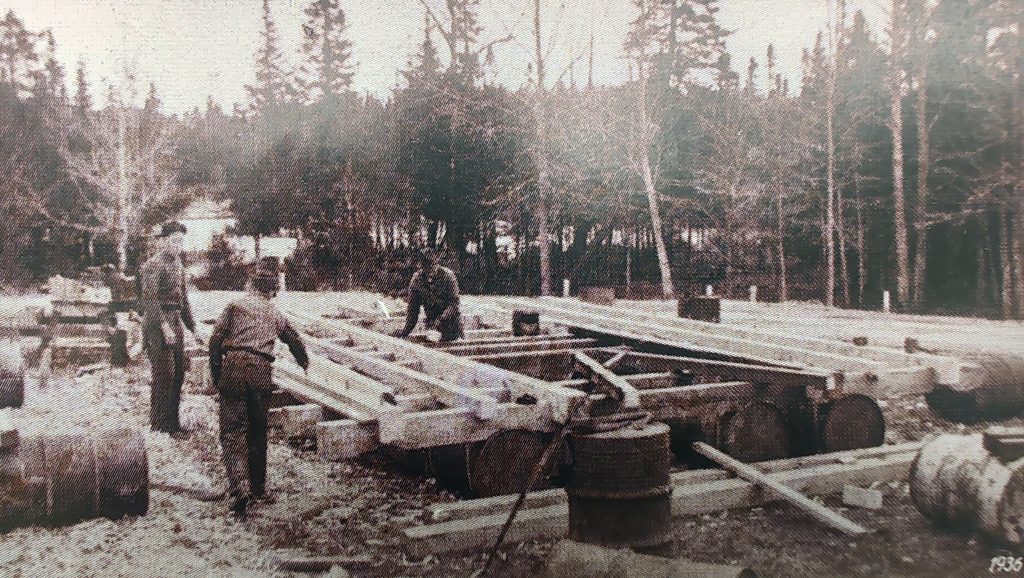
Photo Credit: Kitch-Iti-Kipi visitor center
Geographic History
I had found the geographic history interesting. 420-440 million years ago, known as the Silurian time period, this land had been south of the Equator. Layers of mud and rock had trapped animals of that era. As the Earth had continued to circle the sun, more layers of mud and rock had settled on top of the Silurian layers which had compressed them. Under the pressure, the Silurian layers had become limestone.
Over the course of centuries, this landmass had moved northward. The layers above had eroded away bringing the Silurian limestone near the surface. Around 8,000 years ago, water had seeped through cracks in the soft stone called ‘the cataract formation.’ Tunnels and channels had been created which soon had given way to larger, underground caverns which had filled with water. This aquafer is connected to nearby Indian Lake. I’m amazed by the fact that every single minute ten thousand gallons of fresh water bubble up from the aquafer beneath. It’s a dazzling show; the force of nature!
Ponderings
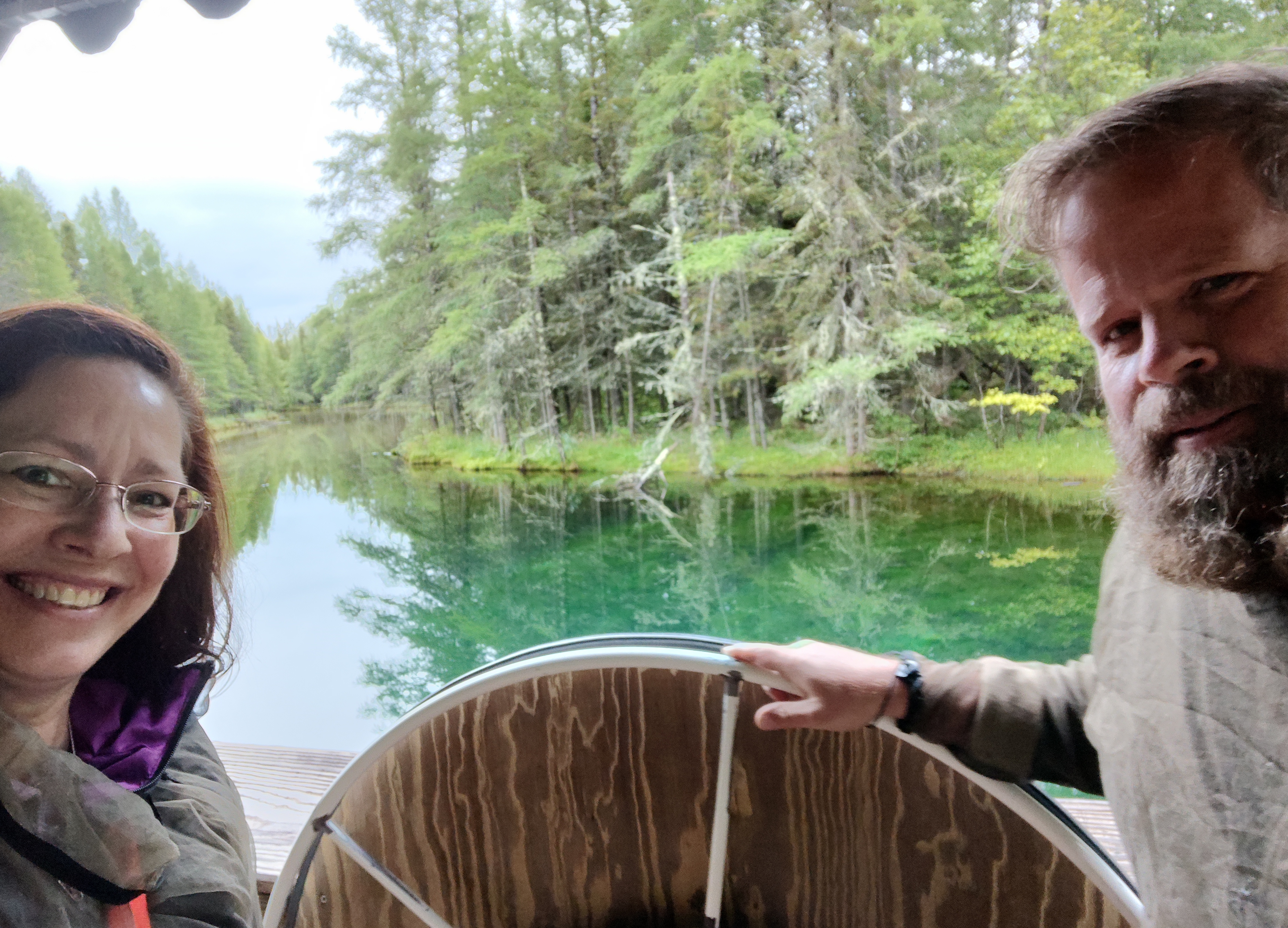
This had been my first time viewing the miraculous wonder of Kitch-Iti-Kipi! I honestly didn’t know it had been here until just a few years ago and I grew up in Michigan. I encourage you visit this site. These photos can’t capture the serene ambiance and the magical colors. I anxiously await my visit here in the winter!
Related Links: Other U.P. Adventures
Restless Viking Articles about Keweenaw!
Restless Viking “Nine Obscure Things To Do In Keweenaw” YouTube video.
Restless Viking “Dog Sledding at Nature’s Kennel” YouTube video.
Restless Viking “Copper Cabin” YouTube video.
Resources:
“The Legend of Kitch-iti-kipi” by Carole Lynn Hare is available on Amazon.
Victor R. Volkman’s book review of Carole Lynn Hare’s book, “The Legend of Kitch-iti-kipi.”
Manistique Tourism website
Kiddle website
Alexis Dahl’s YouTube video





